Glossary
of Decorative Painting Terms
Artezan's glossary of decorative painting
terms is presented with the beginning decorative artist in mind.
While every attempt has been made to include most frequently used
terms, this glossary is far from exhaustive and will be subject
to regular updating.
A B C D E F G H I J K L M N O P Q R S T U V W X Y Z
Acrylic paint:
a synthetic, water-based paint. Its working properties are similar
to oil paint, although it dries more quickly and forms a somewhat
glossier surface. Acrylic paint can be used in thin washes or
applied thickly. It has good coverability and may be used on
most surfaces other than canvas including wood, tin, plastic
etc.
Angle brush: also called "angle
shader". A flat brush with hairs trimmed to form an angle
instead of a straight edge. Usually used for painting tight corners
and to paint certain types of stroke roses. Great for
shading and highlighting, and to paint curved strokes.

Antiquing: a finishing technique
used to age a painted project. Antiquing can be done using oil
paint or acrylic paint.
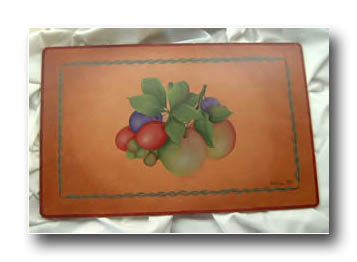
Basecoat: part of the preparation
phase of a decorative painting project. The entire project piece
is painted with a chosen basecoat colour. If painting from a
pattern, the basecoat colour is usually specified as part of
the design.
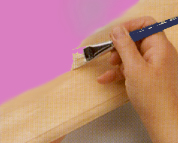
Basecoating brush: a synthetic flat
brush usually 1 inch or 1 1/2 inches wide used for appying the
basecoat color to a blank or object before decorating it.

Blanks: items to paint on made of
wood, particleboard or medium density fibreboard (MDF) usually
available from craft stores.

Bright: usually a long-handled
flat brush with short hairs. The width and length of the brush
head is almost equal. It is usually used in oil painting to make
short, controlled strokes using a heavy load of paint.
Brush holder: may be made
of a variety of materials (fabric, canvas, plastic, leather etc)
specially for storing and or transporting brushes so that the
hairs stay
flat
and are
not
damaged.
Blocking-in: "basecoating" an object in a design to give
it a one-dimensional solid color. These objects may be given a three-dimensional
effect later by adding shadows and highlights.
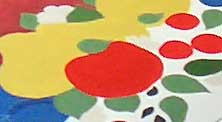
Brush mixing: picking up another
color on the palette with another color already on the brush
and stroking briefly to mix it - as opposed to using a pallette
knife to mix colours.
Brush tub / brush basin: usually
made of plastic, with sections for water to clean your brushes
in and slots to rest your brushes on.
 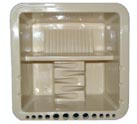
Chisel edge: term used to describe
the completely flat edge of a flat brush or angle brush after
it is loaded with paint.
Clear glaze medium: has a number
of uses - add it to acrylic paints to make it transparent. This
is usually done in faux finish projects or when preparing a stain.
Used on its own and painted over a finished part of your project,
clear glaze medium acts as a barrier coat to seal the painting
already done.
Color palette: the selection of colors
based on the chosen design used to paint a project.
Color wheel: shows the relationship
of and how all colors are derived from the three basic primary
colors of red, blue and yellow. The most commonly accepted color
wheel shows the relationship and derivations of twelve colors
placed in the order of the colors of the rainbow.

Comb/rake: This is a brush used mainly
for creating textures when painting hair, grass, feathers and
fur. It comes in a variety of shapes.

Comma stroke: the most fundamental
stroke in decorative painting. Painted by fully loading a round
brush with paint, pressing the tip down onto the surface, then
pulling the brush towards you in an arc while gradually releasing
pressure on the brush and lifting it into nothing to form the
tail of the stroke. Comma strokes are used to paint daisies and
is the predominant stroke used in most traditional
folk art.

Complementary colors: colors that
lie opposite each other on the color wheel e.g. green and red,
blue and orange etc. Read more about colour in Understanding
Colour.
Composition: the selection and arrangement
of elements for a painting or drawing.
Crackling: the use of crackle medium
to create fine porcelain cracks or large cracks in a background
or finished painted project to simulate an aged object.
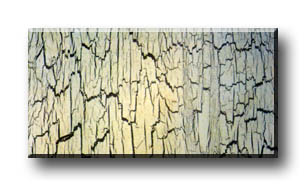
Daggger / striper: so-called because the brush
hairs are shaped like a dagger. It has a long chisel edge and has
a great capacity for holding thin or washy paint. Great for blushes,
painting ribbons and long leaves.

Distressing: creating an aged look
to an object by removing parts of the top layer of paint to reveal
the contrasting basecoat beneath. There are various methods of
doing this.
Double-loading: a technique where
a brush is loaded with two colours of paint. On a flat or angle
brush, a colour is picked up each half of the flat surface of
the brush, then stroked in one direction, then the other to subtly
blend the colors so that they merge in the middle. When painted,
a double loaded brush produces a blended colour with dark on
one side and light on the other and a soft mix in the middle.
Drybrushing: a technique used usually
to add a dramatic and realistic highlight to an object/s in a
design. The technique involves dipping a small bristle brush
in very little paint, wiping off most of it on a paper towel
and applying it to the object in a circular motion.
Extender: also called retarder or
antiquing medium. As the name implies, it is used to prolong
the opening or working time of acrylic paint. It may also be
used when doing water-based antiquing.
Fan brush: a flat brush where the
hairs are spread and shaped like a fan. Usually used with very
little paint to create a feathery or leafy texture.

Ferrule: the metal part of a brush
which attaches the bristles to the brush handle.
Flat brush: a brush where
the ferrule is crimped so that the brush hairs are flat instead
of pointed as in the round brush. The length of the brush hairs
vary from medium to long. Various sizes are available for use
in strokework, basecoating, shading and highlighting.

Flat comma: a comma stroke painted
using a flat brush.
Flip-float: a technique used to paint
highlights for example on a ribbon. A float is applied using
one side of the brush then flipped over to paint with the other
side.
Floating: a technique referring to
the use of a side-loaded flat brush to paint shadows and highlights.
See also Side-loading.
Filbert: a type of flat brush with
a rounded edge usually used to create soft edges and blend colors.
Also known as "cat's tongue". Great for sstrokework
projects and to basecoat objects in a design.

Full Load: when a brush is completely
loaded with one colour of paint.
Gesso: an Italian word which means
a chalky substance. The traditional gesso is a mixture of this
chalky substance with rabbitskin glue and is used to seal the
surface prior to painting. Acrylic gessos are more commonly used
today instead of the traditional gesso.
Gilding: the application of gold
or silver leaf to an object or surface to give the effect of
solid or inlaid metal.
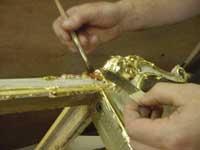
Glazing: the application of a transparent
coat of paint over a previously painted and dried coat. Whatever
you have painted below will still be visible after the
glaze has been applied - only the color cast changes. This is a
technique that has been used for centuries in fine art. Paint used
in glazing is best made transparent using a clear glaze medium.
Gouache: technically, gouache is
a French term for opaque watercolors. Gouache resins are different
from those used in the formulation of acrylic paints. They can
be reconstituted with water so in that way are similar to water
colours.
Heel (of an angle brush): the short
edge of an angle brush

Highlight: in a painting, the representation
of the brightest point where light hits an object . Usually the
lightest tone (usually white or the very lightest tone of a particular
colour) in the painting.
Highlighting: the act of applying
a highlight to an object being painted. The opposite of shading.
Hue: the basic name assigned
to a color.
Intensity (of color): how bright
or dull a color is. Also called "saturation".
Intermediary colors: the six colors
that are created by mixing a primary and its closest secondary
color on the color wheel e.g. red orange - red + orange
Liner: a brush with few hairs which
are shorter than a script liner although much longer than round
brushes. They are an essential in decorative painting for painting
straight or curved lines as well as lettering and also stroke
borders.

Load (a brush): to fill a brush with
paint by dipping the brush hairs in a puddle of paint and pulling
it towards you.
Matte: flat and not glossy, having
the appearance of a dull surface.
Masking out: the application of low-tack
masking tape, "magic tape", stencil tape or masking
fluid (a sort of rubber solution) to selected areas on a painting
project when using certain techniques of faux finishes, for example.
Masking or other tape if used may be carefully trimmed to suit
the design using a craft knife. Masking fluid is applied using
a brush. Once the technique is completed, masking tape or dried
masking fluid is carefully peeled away.
Mediums: substances which when added
to acrylics changes the paint's qualities. For example, thickening
mediums including texture paste make the paint thicker so that
brush marks show and textures can be created. Flow medium is
used in place of water to thin the paint for basecoating or to
create washes. Glazes create transparency. Retarder slows down
the drying time.
Multi-loading: technique of loading
a brush (usually round brush) with up to three different colours.
The brush is usually fully loaded in one color after which the
second and third colors are picked up.
Primary colors: the three colours
- red, blue and yellow - which cannot be obtained by mixing any
other colors. All other colours are however obtained by mixing
from them. Read more about colour in Understanding
Colour.

Round brush: a brush where the ferrule
is round and the brush hairs form a pointed tip, in various sizes.
The round brush is the brush usually used for projects where
the comma stroke is predominant. Most traditional folk art was
done using a round brush.

Script liner: This is a liner with
long hairs which are best used with thin, watery paint to paint
scrolls and long lines. The long brush hairs hold more paint
than the standard liner.

Scumbling: a background technique
where a second, usually lighter, color is thinly or loosely brushed
in a "slip-slap" manner over an under-painted area
so that the painted area beneath it shows through.
Sealer: a medium which is usually
brushed on a blank, raw wood piece or any other surface like
metal , plastic etc to seal it before applying any paint.
Secondary colors: the three colors
that are obtained from mixing two primary colors as follows:
orange (yellow + red), green ( yellow + blue), and violet (red
+ blue). Read more about colour in Understanding
Colour.

Shade: made when a color's value
is reduced or darkened by the addition of black or a dark value
color to it.
Shading: the opposite of highlighting
where an area on an object being painted is darkened to give
the appearance of a shadow. Shading gives the painted object
a three-dimensional look.
Side-loading: technique used for
painting shadows and highlights where a flat brush is loaded
with paint only in one corner then stroked in one direction so
that the paint is spread across the brush about halfway.
If necessary to add water to the brush, the other corner may
be tipped in a bit of clean water. When painted, the resulting
stroke is a gradation of solid color to nothing.
Spattering: also known as fly-speckling
or splattering, is a technique which literally involves sprinkling
a raw wood surface or painted background with light consistency
paint usually of a darker color. A large brush loaded with watery
paint or a fly speckler is usually used.

Spotter: like a liner but with even fewer but
very short hairs. Used in decorative painting for detail work,
including of course, spots.

Stencil brush: a brush often with
short, stiff bristles usually used in stencilling work but is often
used in faux finish applications for stippling. Also useful when
creating foliage.

Strokework: specific and distinct
brush strokes which are formed by applying a single stroke of the
brush whether flat, angle, round, filbert or liner
Stylus: a tool usually consisting
of a wooden or plastic handle with a smooth metal tip on its
end. Some coe with two tips, one on each end of the handle. One
end is usually a finer tip than the other. In decorative painting,
it is used primarily to transfer a design from a tracing onto
the project. It is also used to make dots with paint.
Temperature (of color): how warm
or cool a color appears to be.
Tertiary colors: mixed colors which
contain all three primary colors. Read more about colour in Understanding
Colour.

Textile medium: a medium added to
acrylic paint for the purpose of painting a design on fabric.
Tile medium: a medium added to acrylic
paint to create permanency when painting on tiles, ceramics or
glass.
Tint: made when a color's value is
reduced or lightened by the addition of white or a light-value
color to it.
Tipping: loading a round brush full
of paint in one colour, then dipping the tip of the brush in
another color to pick up just a small amount of it. The resulting
stroke has a variegated appearance. The brush may also be tipped
in two colours to give a multicolored stroke.
Toe (of an angle brush): the long
edge of an angle brush

Tole: French word for tin or metal
ware
Tone: made when a color is mixed
with gray or any other color to reduce its intensity.
Transfer Paper: paper coated
on one side with gray, black, white, blue, or red material used
to transfer a design to the surface to be painted. Transfer paper
is placed color side down between the project surface and the
tracing of the pattern. A stylus or pencil is then used to go
over the design to leave an imprint on the basecoated projected
surface.
Triple Load: when a brush (usually
a flat brush) is loaded with three colours of paint. The brush
is first completely loaded with the base colour. Then, one half
of the brush is dipped into a second colour, and the other half
into a third colour. Then the brush is stroked three or four
times on the palette and flipped over and repeated. This produces
a soft blended stroke.
Trompe l'oeil: a French term meaning "trick
the eye". In painting, it is used to describe painted work
that are so realistic as to fool the viewer into thinking the
objects in the painting are not painted, but real.

Value: how light or how dark a color
is.
Value scale: gradations of dark to
light beginning with black and ending with white.

Varnish: completed decorative painting
projects are sealed with many layers of varnish to protect it
and give it a professional appearance. Water-based polyurethane
is available in matte, satin and gloss finishes for the decorative
artist. While they are usually brushed on, spray on varnish as
well as pour-on varnish is also available.
Walking color: a term used in "floating" a
shadow or highlight. Refers to making several, shape-following
floats that gradually move away from the original float. Also
referred to as "walking the brush".
Wash: created using thin watery paint
- achieved with water, flow medium or extender - and best painted
using a flattened round brush. Painting several layers of wash
over each other once the bottom layer has dried creates a "light
from within", translucent effect.
Wet pallette: available from
art suppliers or homemade and is used to keep acrylic paints
moist while painting. Usually with covers so that unfinished
paints may be kept for another painting session. Paints kept
in a wet pallette can be used again even after a month. Several
brands are available.
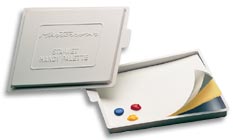
Woodgraining: using paint to imitate
wood effects on blanks. Specific tools for woodgraining are also
available at craft stores.
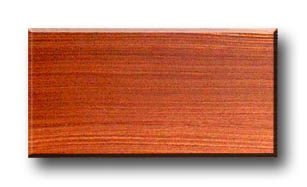
|